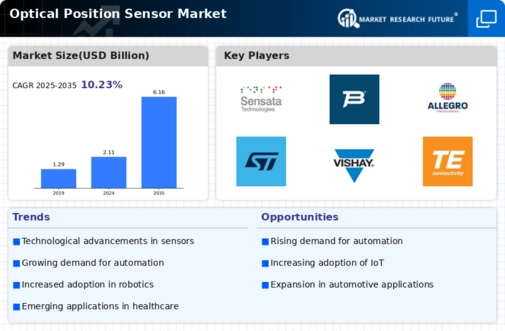Market Analysis
In-depth Analysis of Optical position sensor Market Industry Landscape
The Optical Position Sensor Market is characterized by dynamic and multifaceted market dynamics that influence its growth and evolution. One of the key driving forces is the relentless technological advancements in sensor technology. With automation and precision taking precedence across industries, there is a never-ending requirement for optical position sensors that can deliver better accuracy in addition to faster response times with more reliability. Continuous technological evolution dictates innovation, making producers manufacture advanced sensors that respond to changing needs of various applications.
Another crucial factor affecting market dynamics is the increasing variety of applications for optical position sensors. They are used in automotive, aerospace healthcare sectors of consumer electronics and industrial automation. Optical position sensors display great versatility leading them to become essential constituents of many varieties of devices that support continued market development. In turn, the growing introduction of these sensors into upcoming technologies such as robotics and autonomous cars drives market dynamics to open new challenges for industry players.
In addition, global focus on energy optimization and sustainability contributes greatly to the market dynamics. Optical position sensors, through a non-contact sensing mechanism, have several advantages when compared to conventional contact based sensor types which include improved energy efficiency contamination and radiation resistance. With the increased realization of environmental concerns for both consumers and industries, eco-friendliness becomes a major factor that affects market dynamics; hence manufacturers emphasize on green sensor technologies.
The regulatory landscape also impacts the dynamics of market. Industry standards and regulations follow, particularly in safety-sensitive sectors such as the automotive and aerospace industry. The continuous development of standards and the introduction of new standards affect product manufacturing processes, as well as market entry strategies. Compliance with these standards is not just a legal necessity but also helps the company win consumers’ trust and thus gain an advantage over rivals.
In contrast, market dynamics have problems like the cost restrictions. The manufacturers have to find a balance between providing budget-friendly solutions and retaining profitability in their market, which is highly competitive at times. Cost-saving manufacturing methods, mass production and supply chain optimization emerge as determining factors for solving these problems.
In addition, macroeconomic factors and geopolitics play a significant role in the volatility of market dynamics. Economic slowdowns and concerns about the stability of foreign trade may affect the global demand for optical position sensors.
The market dynamics are highly influenced by the new market entrants and competition. As more players enter the optical position sensor market, competition intensifies. Established companies must continuously innovate to maintain their market share, while new entrants strive to differentiate themselves through disruptive technologies or unique value propositions. Mergers, acquisitions, and strategic alliances become strategic tools for companies looking to strengthen their position in the market.











Leave a Comment